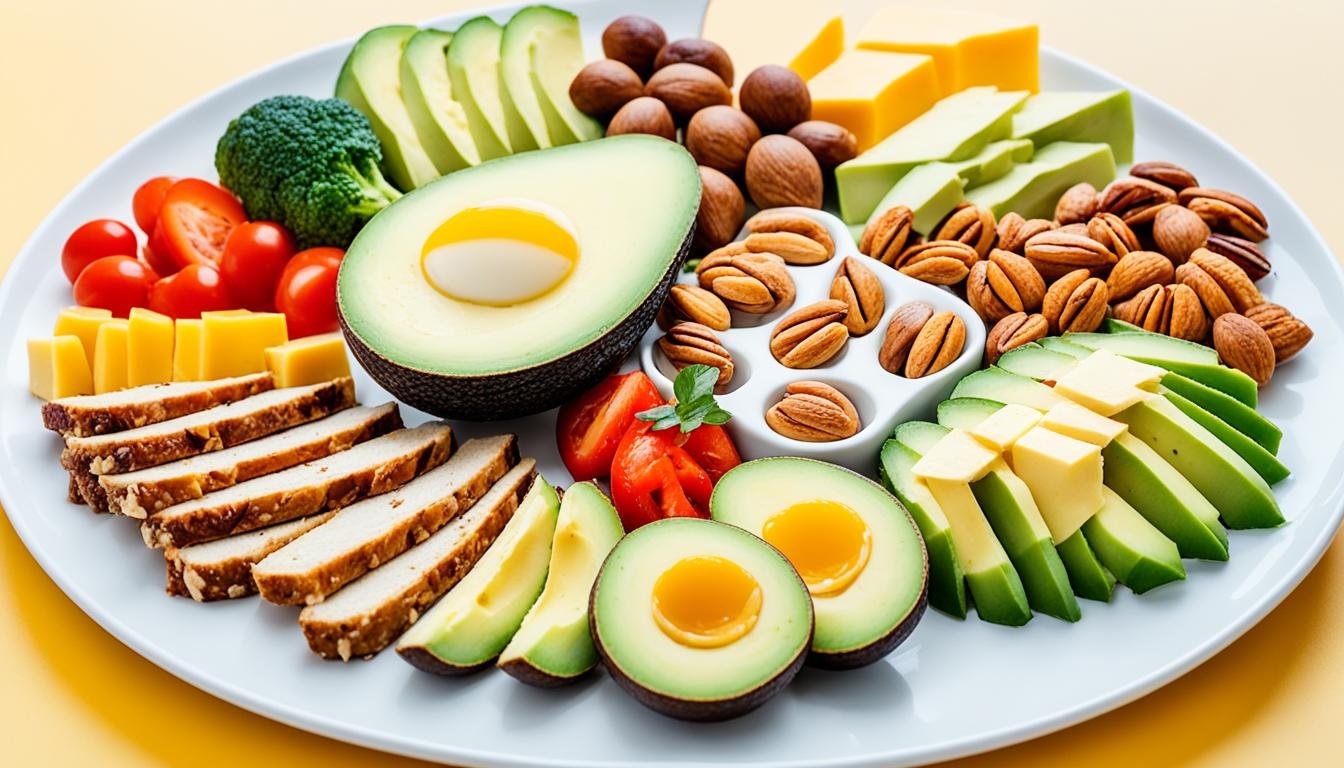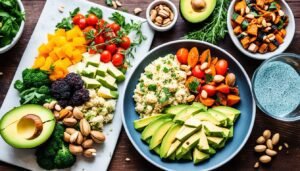The ketogenic diet is popular for its perks like weight loss and better blood sugar. But, sticking to it can be hard for some people. That’s where the cyclic keto diet helps. It’s a flexible way to eat that can be especially good for athletes and anyone wanting to build muscle.
The cyclic keto diet is all about switching between eating very few carbs and lots of healthy fats, and eating more carbs but little fat. By going through these cycles, you get the benefits of being in ketosis. At the same time, you can boost your energy for workouts and support your muscle growth.
Key Takeaways
- The cyclic keto diet involves more carbs for 1-2 days after eating keto for 5-6 days.
- On those higher-carb days, carbs should be 60-70% of what you eat. Protein should be 15-20%, and fats 5-10%.
- This way of eating might help you get stronger and do better in sports, but there isn’t a lot of research yet.
- If you move from a regular keto diet to this one, you might see a short-term weight gain because of water.
- It’s key to be used to burning fat for fuel before trying the cyclic keto diet. Usually, that takes about a month on a regular keto diet.
What is the Cyclic Keto Diet?
The cyclic keto diet is different from the ketogenic diet. It doesn’t just focus on low carbs all the time. Instead, it includes days for eating more carbs to help your body regain energy.
You follow a ketogenic diet plan for most of the week. This means low carbs, only 20-50 grams, for 5-6 days. Then, you have 1-2 days where you eat more carbs, 60-70% of your calories. We call these days “refeeding” days. This back-and-forth helps you stay in ketosis without drawbacks over time.
The aim of these refeeding days is to top up your body’s energy stores. This can be good for people who are very active, like athletes or bodybuilders. It might help them perform better and manage their weight on a low-carb plan.
“The cyclical keto diet involves adhering to a standard ketogenic diet 5–6 days per week, followed by 1–2 days of higher carb consumption.”
How the Cyclic Keto Diet Works
The cyclic keto diet is all about the timing in eating. It asks you to watch how much carb intake you get. For the standard ketogenic diet days, keep carb intake low, between 20-50 grams a day. This helps your body to burn fat for energy, not carbs. Make sure healthy fats are a big part of what you eat, around 65-90% of your daily calories.
Now, on refeeding days, things change. You should get most of your daily calories from carbs, about 60-70%. Proteins should still be important, making up 15-20%. Fats, however, become a smaller part, only 5-10%. This bump in carbs helps fill up your body’s glycogen stores. It gets you ready for more low-carb days.
| Macronutrient Ratio | Standard Keto Days | Refeeding Days |
|---|---|---|
| Carbs | 20-50 grams | 60-70% |
| Protein | 15-20% | 15-20% |
| Fats | 65-90% | 5-10% |
This diet mixes low-carb times with times of more carbs. This way, you get the good parts of both ways of eating. By going back and forth, you can help your body work better. It’s good for your looks, how you feel, and your health overall.
“The primary goal of the cyclical ketogenic diet is to temporarily switch out of ketosis to refill muscle glycogen and enhance training performance.”
Cyclic Keto Diet vs. Standard Keto Diet
The cyclic keto diet and the standard keto diet are two different types. The standard keto diet keeps carbs very low, under 5% of total calories, and fats high, at 70-80%. In contrast, the cyclic keto diet changes between low and high carb days.
On standard keto days in the cyclic plan, you eat similar to the standard keto diet. This means 20-50 grams of carbs and 65-90% of calories from healthy fats. On “refeeding” days with more carbs, carbs can be 60-70% of your intake. Fats would only be 5-10%, and protein about 15-20%.
| Macronutrient | Standard Keto Diet | Cyclic Keto Diet (Standard Keto Days) | Cyclic Keto Diet (Refeeding Days) |
|---|---|---|---|
| Carbs | ≤5% | 20-50 grams | 60-70% |
| Fats | 70-80% | 65-90% | 5-10% |
| Protein | 20-25% | 20-30% | 15-20% |
The cyclic way aims to get benefits from low-carb and high-carb times. Low-carb days help with fat loss and stay in ketosis. Refeeding days may boost muscle growth through the effects of insulin.
Both the cyclic and standard keto diets have pluses and minuses. The right choice depends on your goals and health. Always talk to a doctor before trying the cyclic keto diet or other keto variations.
Benefits of the Cyclic Keto Diet
The cyclic keto diet mixes in some higher-carb days. This approach is great for people wanting to gain muscle. Also, it boosts athletic performance.
Muscle Growth on Refeeding Days
The cyclic keto diet can help in building muscles. Refeeding days with more carbs let the body use insulin better. This helps in muscle growth and healing. It also fills the glycogen stores, which is good for creating muscle.
Boosting Athletic Performance
It’s excellent for athletes too. With more carbs on certain days, they get more energy for tough training. This method makes sure athletes have plenty of energy. That way, they can do better in their sports.
“Combining the ketogenic diet with strategic carbohydrate refeeding can significantly enhance both muscle growth and athletic performance.”
The cyclic keto diet mixes low and high-carb phases. This way, it brings the best of both worlds. It’s especially great for getting better muscle gain and athletic performance.
Cyclical Keto Diet Foods
The cyclical keto diet needs careful food planning. This ensures you get the right nutrients all week. On keto days, eat low-carb foods to maintain the fat-burning state.
Low-Carb Foods for Standard Keto Days
- Meat: Beef, pork, chicken, turkey, and lamb
- Poultry: Chicken, turkey, and duck
- Eggs: Whole eggs and egg-based dishes
- Dairy: Cheese, heavy cream, butter, and full-fat yogurt
- Fish and Seafood: Salmon, tuna, trout, and shellfish
- Low-Carb Vegetables: Leafy greens, broccoli, cauliflower, zucchini, and bell peppers
- Nuts and Seeds: Almonds, walnuts, chia seeds, and flaxseeds
Eating these low-carb foods helps you stay in ketosis. This means your body uses fat for energy instead of glucose.
Complex Carbs for Refeeding Days
On refeeding days, focus on complex carbs. They help fill your glycogen stores and give you more energy. Some good choices are:
- Sweet Potatoes
- Chickpeas
- Beets
- Butternut Squash
- Whole Grains: Quinoa, brown rice, and oats
- Beans: Black beans, kidney beans, and lentils
These carbs are full of fiber, vitamins, and minerals. They give you a healthy energy boost for working out and recovering.
“Cyclical keto lets you enjoy the ketosis benefits. It also provides the carbs for intense training and muscle growth.”
How to Follow the Cyclic Keto Diet
To start, do a standard ketogenic diet for a month. This gets you to a fat-adapted state. Your body learns to burn fat for fuel well.
After becoming fat-adapted, switch between 5-6 days of the keto diet and 1-2 days of more carbs, or refeeding days. This helps you stay in ketosis while refilling your body’s glucose stores.
Standard Keto Days
On keto days, eat 20-50 grams of carbs. Make sure healthy fats make up 65-90% of your calories.
Refeeding Days
On refeeding days, carbs should be 60-70% of your calories. Protein is 15-20%, and fats are only 5-10%.
Cycling between low and high carb days can help with weight loss or better performance. It lets you enjoy the keto diet’s benefits.
| Macronutrient Ratio | Standard Keto Days | Refeeding Days |
|---|---|---|
| Carbs | 20-50 grams | 60-70% of total calories |
| Protein | 15-20% of total calories | 15-20% of total calories |
| Fat | 65-90% of total calories | 5-10% of total calories |
Always listen to your body and adjust as needed. Find what works best for you with the cyclic keto diet.
Potential Drawbacks of the Cyclic Keto Diet
The cyclic keto diet has its benefits. But, it also has some downfalls. You might eat too many calories on refeeding days. This could cancel out weight loss from the keto phase.
Switching from a strict keto to a cyclic one can cause a brief weight increase. This is often just water weight due to more carbs on those days. Some people find this extra weight discouraging.
Sometimes, you might become relatively glucose intolerant when on the keto diet. This means your body doesn’t handle high-carb meals well. It could cause issues like harm to blood vessels and inflammation.
Experts warn against going back and forth between keto and high-carb diets. It might not be good for your heart’s health over time. The changes in what you eat and how much can be tough to handle.
“Continuing to switch between keto and higher carb diets may lead to more harm than benefit over time, specifically with regards to risk factors for cardiovascular disease.”
Being careful and informed is key when trying the cyclic keto diet. Keep an eye on your body’s reactions. Adjusting as necessary can help make the diet more beneficial than harmful. Always talk to a doctor before changing your diet significantly.
Cyclic Keto Diet for Weight Loss
The cyclic keto diet might help with better sports performance and building muscles. But, we’re not sure if it’s great for losing weight over a long time. We need more studies to see if changing between high and low carbs is better for weight loss. How much you eat, what you eat, and how your body reacts could all affect the results.
Normally, keto diets tell you to eat less than 50 grams of carbs a day. The cyclic keto diet mixes this by having 5-6 days of low carbs and 1-2 days with more carbs. This mix is to fill up your energy stores. It might help you do better in sports and grow your muscles.
On low carb days, most of your calories should come from healthy fats. Protein and carbs should only make up a small part. Then, on carb-heavy days, most of what you eat should be carbs. This helps your muscles store water and energy again.
The cyclic keto diet has some good points. But, not everyone who wants to build muscles or do better in sports needs it. We need more studies to know for sure how good or bad it is for losing weight and being healthy.
“Consuming excess carbs on refeeding days may lead to temporary weight gain due to water retention, as each gram of carbs stored in muscle holds at least 3 grams of water.”
If you think the cyclic keto diet is for you, start with regular keto for a month or more. This makes your body used to burning fat. Then, see how you feel adding more carbs some days. Keep an eye on how your body reacts. The most important thing is to find a way of eating that you can keep up with and that gives you all the good nutrients you need.
Conclusion
The cyclical ketogenic diet is a unique way for weight loss and better health. It combines a standard keto diet with strategic carb-loading. More research is needed to know its long-term effects and downsides. But, it could improve how well we perform in sports and grow muscles for some.
Starting with the cyclical keto diet means first doing a standard keto diet for a month. This makes your body get used to burning fat for energy. Then, you can try cycling between 5-6 days of keto and 1-2 days with more carbs. Watch how your body reacts and change your plan as you learn more.
How well the cyclical keto diet works for you depends on what you want, like, and how your body works. Knowing its key points and advantages helps you pick if it’s good for your goals or health. Always talk to a health expert to make sure this diet fits your special needs.




